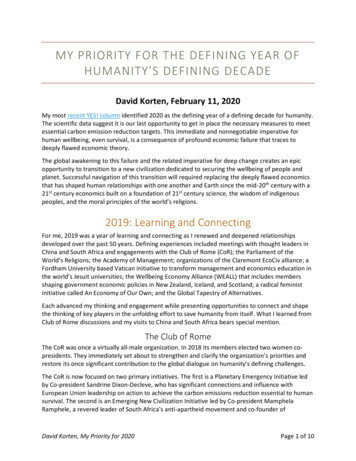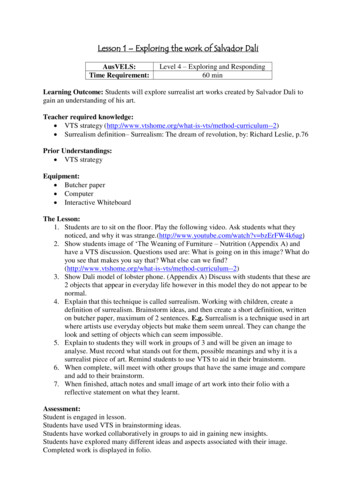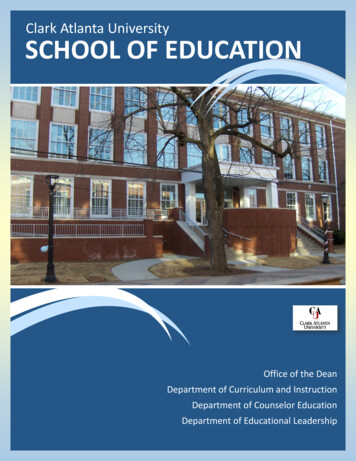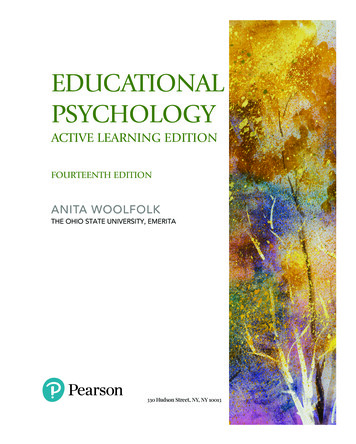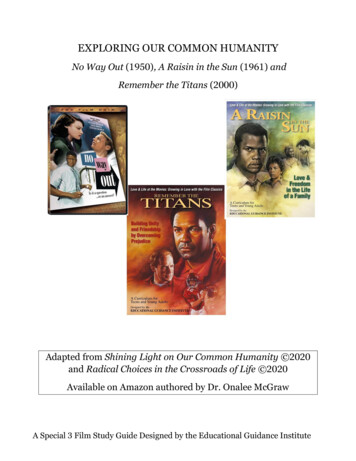
Transcription
EXPLORING OUR COMMON HUMANITYNo Way Out (1950), A Raisin in the Sun (1961) andRemember the Titans (2000)Adapted from Shining Light on Our Common Humanity 2020and Radical Choices in the Crossroads of Life 2020Available on Amazon authored by Dr. Onalee McGrawA Special 3 Film Study Guide Designed by the Educational Guidance Institute
OVERVIEWWe all have very different life experiences and, yet - we share the samehuman nature! A truly great classic film shines the light of truth on ourlives and illuminates our common world. Classic films are rememberedand viewed again and again because they help us discover who we areand how to live together in the human family.The films included in the EducationalGuidance Institute Study Guides have beenchosen according to the highest aestheticstandards for screenplay, direction, acting,casting, and artistic integrity. The clear andconsistent moral content of these films servesto elevate the human spirit and inspire themoral imagination for the good, the true andthe beautiful.Together we can restore our diminished treasury of social and moralcapital. We can deepen our understanding of our shared human conditionand rebuild civic friendship!April 2014 was Turner Classic Movies’ 20th anniversary as a leadingauthority in classic film. Turner Classic Movies invited EGI’s OnaleeMcGraw and 19 other filmfans to introduce theirfavorite movies with TCM’sHost, Robert Osborne.Introducing 12 AngryMen, Robert Osborne andOnaleediscussedtheuniversal theme of justiceportrayed in the film.Exploring Our Common Humanity 2020 Educational Guidance Institute1
“Moral communities are fragile things, hard to build and easy to destroy.”- Jonathan HaidtOur job must be to rebuild the moral and social capital that sustains usliving together in community and society. Jonathan Haidt, moralpsychologist and best-selling author of The Happiness Hypothesis and TheRighteous Mind, defines moral capital as “the resources that sustain amoral community.” As Haidt puts it,“Moral capital refers to thedegree to which a communitypossesses interlocking sets ofvalues,virtues,norms,practices, identities, institutions,and technologies that mesh wellwithevolvedpsychologicalmechanisms and thereby enablethe community to suppress orregulate selfishness and makecooperation possible.”In a mysterious way, the visual art of classic film supplies essential moralvision in a fractured society. Sharing this vision, we can revitalize our coreinstitutions and restore dangerously depleted moral and social capital. Aclassic film transports its viewers into a world where the meanings oftruth, goodness and beauty are not in dispute.Exploring Our Common Humanity 2020 Educational Guidance Institute2
No Way Out (1950)Directed by Joseph L. MankiewiczJustice and the Examined LifeExploring Our Common Humanity 2020 Educational Guidance Institute3
No Way OutMade in 1950, a decade before the civil rights movement began, this film unearths fearand hatred as the emotional roots of racism. Darryl Zanuck, production head of 20thCentury Fox, and Joseph Mankiewicz, one of the most respected directors andscreenwriters at the studio, collaborated on the project. No Way Out was the firstscreenplay out of Hollywood that squarely took on racism as a social issue.StorylineNo Way Out is the story of conflict between a nearpsychotic white man, Ray Biddle (Richard Widmark), and ayoung black doctor, Luther Brooks (Sidney Poitier). Ray andhis brother Johnny, shot while caught in a robbery, arebrought to the prison ward where Dr. Brooks is an intern.After examining Johnny, Brooks suspects a brain tumor andperforms a spinal tap to confirm his diagnosis.When Johnny dies Ray claims Brooks has deliberatelymurdered his brother. The hospital supervisor, Dr.Wharton (Stephen McNally), knows Brooks to beinnocent, but Biddle will not allow an autopsy to prove it.The two doctors seek the help of Edie Johnson Biddle,Johnny’s widow (Linda Darnell) to get the autopsy.Biddle’s manipulation of Edie results in a race riot overJohnny’s death.Edie seeks refuge in Dr. Wharton’s home,becoming friends with the doctor’shousekeeper, Gladys (Amanda Randolph).Through her friendship with Gladys, Edieovercomes her prejudice against blacks.Brooks sees the only way he can get theautopsy is to turn himself in to the police.After Brooks is cleared, Biddle is determinedto kill him.Biddle forces Edie to lure Brooks to Wharton’s home where he tries to kill him. In thefinal scene, as Ray Biddle’s wound starts to bleed, he finds himself dependent on the manhe hates to save his life. Edie says that Ray doesn’t deserve to live, but Luther Brooks saysto her, I can’t kill a man just because he hates me.Exploring Our Common Humanity 2020 Educational Guidance Institute4
Film Facts: No Way OutYear: 1950Starring Sidney Poitier, RichardWidmark, Linda DarnellDirector Joseph L. MankiewiczScreenwriter Joseph L.MankiewiczViewing Time: 106 MinutesNo Way Out in Film History: A Case Study in Institutional RacismThis landmark film brought together two men who became lifelong friends, RichardWidmark and Sidney Poitier. Widmark was the seasoned professional who had started hisfilm career in 1947 playing an evil villain who pushesa helpless old lady down the stairs in Kiss of Dark.Richard Widmark’s co-star, Sidney Poitier, was justtwenty-three and appearing in his first film. Widmarkhad been asked by Zanuck and Mankiewicz to play acharacter starkly opposed to his own deep convictionsabout human dignity and racial justice. Widmark didnot want to play a bad guy again but he did it for thegreater good that could come a film showing the evilsof racism and featuring black actors in portrayals ofwhole persons instead of stereotypes.Sidney Poitier went on to become the leading man who paved the way and set the standardfor the many black actors who followed him. He is most remembered for his roles as Mr.Tibbs in In the Heat of the Night. his Broadway and film performance as Walter LeeYounger in A Raisin in the Sun. and his Oscar winning performance in Lilies of The Fieldin 1964.Exploring Our Common Humanity 2020 Educational Guidance Institute5
Film Critic’s CornerThe Elevation of Human Dignity Depicted in No Way Out.Joseph Mankiewicz and Darryl Zanuck were known in Hollywood for boldness intackling controversial themes. Theyneeded an exceptional actor to play thepsychopathic racist, Ray Biddle.Widmark had gained stardom byplaying psychotic villains but did notwant to be typecast as a villain. As astrong supporter of civil rights,Widmark did not relish playing the partof Ray Biddle. Zanuck and Mankiewiczwere able to convince him that the roleonly he could play would serve thecause of social justice.The Brilliance of Motion Picture Art: Dialogue, Direction and PerformanceJoseph Mankiewicz had begun his career as a screenwriter and continued in that craft formany years. The story of his talent as both screenwriter and director is told in Oscarnominations and awards he won at the peak of his career. In 1950, Mankiewicz won bothBest Director and Best Original Screenplay Awards for A Letter to Three Wives. In 1951he won Best Director and Best Original Screenplay for All About Eve. In that same yearhis script for No Way Out was also nominated.Film critics and fans often speak of the high literary quality and wit in the writing ofJoseph Mankiewicz. In a May 1991 interview, Mankiewicz reflected on the markeddecline in creativity he was seeing in the contemporary films of the day with thiscomment:“I’m just a little bit sad about the kinds of movies they’re making now Today’sfilms don’t seem to exist without the destruction of property, the destruction ofhuman beings, the actual stripping of any kind of mystery or individuality,really, from sex, by putting as much as possible on the screen ”Exploring Our Common Humanity 2020 Educational Guidance Institute6
Acting for the Good as an Antidote to RacismThe corrosive effect of racial animosity on individuals, institutions and society is thecentral theme in No Way Out. The story teaches the lesson that the only effectivecounterforce to racial hatred is personal virtue and friendship. We see this enduring truthabout human nature in the growth of virtue and friendship in its lead characters. The storyflows without the kind of preachy over- simplification of complex social problems thatsometimes diminishes other films with racial themes. The pioneering nature of this film isremarkable because in the time it was made race was not a subject of civil discourse in thenation.Luther Brooks has an authentic friendship ofequals with Dr. Wharton who is his supervisorat the hospital. The moral support LutherBrooks receives from his family strengthens hiswill to persevere in the face of dauntingchallenges. Luther must summon all his innerstrength to gain the solution to the murdercharge against him. He decides to turn himselfinto the police so the autopsy can be done.Edie has grown up in oppressed circumstances, alife filled with bitterness, hardship, and racism.Gladys teaches her how to see blacks as humanbeings and the two women become friends.Edie learns that righteous anger can never justifyrevenge. She learns this lesson from Luther in thefinal scene. She tells Luther that Ray Biddle is notworth saving and that he should just let him die.Luther gives to Edie, and to the audience, thetimeless lesson on the universality of human dignitysaying, I can’t kill a man just because he hates me.Exploring Our Common Humanity 2020 Educational Guidance Institute7
Post-Viewing Discussion: No Way OutIn the beginning Edie allows her upbringing inBeaver Canal to define who she is. Seeing herself asa victim unable to control her own life, she is easilymanipulated by Ray Biddle. She delivers themessages from Ray to his friends in Beaver Canalthat put the race riot in motion.Discuss how Edie’s interactions with Gladys, Dr. Wharton, and Dr.Brooks and his wife allow her to push beyond her upbringing and becomeher own person.Moral Intuition that Evil Has HappenedEdie experiences deep feelings of disgustand horror when she witnesses the harmand destruction, she has caused by bringingRay Biddle’s messages of hate to BeaverCanal. She begins to realize Ray Biddlehas manipulated her and she wants no partof Beaver Canal.Understanding through FriendshipThrough her conversation with Gladys,Edie gains a deeper understanding of thecommon ground that she and Gladysshare. They talk about what they do anddo not understand about men and whymen do the things they do. Edie feelsgenuine gratitude towards Gladys fortaking care of her and wants to know moreabout her.Exploring Our Common Humanity 2020 Educational Guidance Institute8
Post-Viewing Discussion (Continued)We do not grow in self-knowledge and virtue all at once. We learn to dothe good through the example and compassion and friendship of others.Growing in EmpathyDr. Wharton takes Edie with him to thecoroner’s office. She is there whenLuther is exonerated and, in front ofRay, she says to Luther and his wife:I’m glad it turned out alright I’mglad for both of you.Recognizing Human Dignity as a Universal GoodHaving been hurt so many times byRay, Edie is at first reluctant to helpLuther save Ray’s life. She says Letit bleed. But Luther shows her thateven though Ray is crazy andhorrible, he is still a human beingand deserves to be treated as such.Luther says:I can’t kill a man just because hehates me.Exploring Our Common Humanity 2020 Educational Guidance Institute9
The Filmmaker and his story Recognizing Human Dignity as a Universal Goodas Portrayed in No Way Out: The Ideas are in the Images“It is nonsense to imagine that a free political community can survive withoutcitizens who pursue lives of virtue.”- James MadisonJoseph Mankiewicz had the talent to express through dialogue and image deepconcepts in the human condition. The Oscar winning screenwriter and director grewup in a home in which serious and literate conversations took place on a daily basis.Mankiewicz’s father was a professor at a university. His brother, HermanMankiewicz, is famous in Hollywood history for writing the screenplay for OrsonWells’ Citizen Kane.The central narrative in No Way Out speaks directly to the civil divides and tribalconflicts we are experiencing in our society today. Many of the characters in thisstory, both black and white, are seen as nursing tribal hatreds and driven by thedesire for violent revenge. Other characters, and in particular the character ofEdie, are able to overcome their narrow view of tribal identity. As we see in NoWay Out, the deeply philosophical concept of universal human dignity is madeconcrete in the natural give and take conversation between Edie and Gladys inthe scenes at Dr. Warton’s home. The concept of human dignity as a universalgood is portrayed in the final scene when Sidney Poitier’s character follows notonly his training as a doctor but his moral instincts as a human being.Exploring Our Common Humanity 2020 Educational Guidance Institute10
A Raisin in the SunThe stage version of A Raisin in the Sunmade history on Broadway. As the reviewersnoted, the largely white audience rose to itsfeet in a spontaneous standing ovation on theopening night. This depiction of a 1950sfamily facing racism and discrimination inChicago presents its characters who cometogether to teach the audience what it meansto be a family.Film FactsYear: 1961Starring: Sidney Poitier, Claudia McNeil,Ruby Dee, Diana SandsDirector: Daniel PetrieScreenwriter: Lorraine Hansberry (play andscreenplay)Viewing Time: 128 minutesSetting: Chicago, IllinoisExploring Our Common Humanity 2020 Educational Guidance Institute11
Film Critics CornerThe great dramaticpower of A Raisin InThe Sun is generated inthe way the entire castworks together as anensemble. In contrast tootherfilmsaboutfamily life which focusprimarilyontheindividuals within thefamily unit, this filmrealistically depicts family life itself. A Raisin in the Sun clearly points to the family asthe teaching ground for learning how human beings behave in community and society.The images of the struggle for unity within the Younger family express for everyone thehuman need for solidarity, acceptance, and self-worth that the family unit is uniquelydesigned to fulfill.A Raisin in the Sun in Film HistoryLorraine Hansberry grew up on the South Side of Chicago where her father was asuccessful real estate broker and her mother was a schoolteacher. In 1938, when Lorrainewas eight, her father moved the family to a white neighborhood, knowing that there were“restrictive covenants” used at the time tokeepminoritiesoutofcertainneighborhoods.Even though they were subjected to attacks,the family refused to move until a courtordered them to do so. The case ofHansberry v. Lee reached the SupremeCourt, ruling restrictive covenants illegal.Lorraine Hansberry’s play made it toBroadway in 1959, and she became theyoungest person and the first AfricanAmerican playwright to win the New YorkDrama Critics Circle Award.Exploring Our Common Humanity 2020 Educational Guidance Institute12
Ruby Bridges and Dr. Robert ColesRobert Coles, Pulitzer Prize-winningHarvard psychiatrist and author, wroteabout his use of films like A Raisin inthe Sun and To Kill A Mockingbird inhis landmark study of The Moral Lifeof Children. Coles interviewed blackand white children on their reactions tothe films and the psychological issuesthe films raised. One of the children, a black child named Ruby Bridges, was among thefirst to be involved in the integration of an all-white school in New Orleans. She had tobe escorted to school by federal marshals due to the hostility of the white people, whoverbally abused her as she made her way into the school. Ruby told Dr. Coles that shehad seen A Raisin in the Sun, and she believed that if white people could see it, “theymight stop coming out to bother us. The people in the movies would work on them, andmaybe they’d listen.”The Brilliance of Motion Picture Art: Dialogue, Direction and PerformanceA Raisin in the Sun debuted in film in 1961, following itssuccessful run on Broadway. Lorraine Hansberry adaptedher play into the screenplay for the movie. The filmportrays the Younger family in their cramped ghettoapartment, just as the audience watched them on stage.Since the cast of the film had already playedtogether for many nights on Broadway, they wereable to deepen their characters in the film while stillkeeping their performances fresh. Ruby Dee (Ruth)has to juggle her role as wife, mother, daughter-inlaw and all-around hostess in a small apartment.She exemplifies the virtue of hope in a confusedworld.Sidney Poitier’s performance is considered hisabsolute best. He takes his character through manydifferent moods and situations, from euphoria to thedepths of despair and ultimately, moraltransformation.Exploring Our Common Humanity 2020 Educational Guidance Institute13
After he knows the money islost, he poignantly cries out:“That money is made out of myfather’sflesh!”Walter’spassion is real becausePoitier’s is.Walter is prepared to accept ” at the expense ofhis family’s honor. He claims that he will “feel fine.” Finally, in one of the mostcompelling scenes ever seen on the screen, Walter Lee is deeply moved by his mother’slove and forgiveness even though he has lost the family’s money. With a great interiorchange of heart he tells the man who represents the white neighborhood that, “We haveall thought about your offer and we have decided to move into our house because myfather—He earned it for us brick by brick.”In his autobiography, The Measure of a Man, Sidney Poitier explains why Walter Lee’scharacter development is the dramatic focus in the movie. "In my opinion," he says, "itwas the son who carried the theatrical obligation as the force between the audience andthe play. The eyes of those watching were on the son to see if the tragedy would destroyhim, would blow him apart beyond recovery. And it was also my opinion that there wasno such feeling between the audience and the mother. The audience witnessed thesadness that was visited on her. They saw that her family was in disarray, but also sawher as a force beyond that kind of vulnerability. If they were to vote, they would say, 'Oh,but she's going to be okay."Poitier is confirming it is Walterwho must successfully riseabove his very real fragility: themother, like a force of nature,will endure no matter what isdecided, but Walter makes adecision which will definitivelyform him--and he makes theright one.Exploring Our Common Humanity 2020 Educational Guidance Institute14
Family, Community, and the Common Good in a Free Society:Lorraine Hansberry’s Vision for A Raisin in the SunAmerican culture from the late 1950s and into the early 1960s was in a time of transition.A Raisin in the Sun appeared on Broadway in 1959 and became a film in 1961. It was atime when many writers in the mainstream white culture were offering the idea that themajor goal in life for all young persons was to become personally autonomous andsuccessful by their own efforts. A Raisin in the Sun dramatized a worldview that was verydifferent from this viewpoint. Hansberry’s creative vision celebrated the family andshowed its beauty in spite of the struggles and divisions within it.Writing to her mother in January of 1959, just before the opening of A Raisin in the Sun,Lorraine Hansberry wrote the following:“The actors are very good and the director is a verytalented man- so if it is a poor show, - I won’t be able toblame a soul but your youngest daughter. Mama, it is aplay that tells the truth about people, Negros, and life and Ithink it will help a lot of people to understand how we arejust as complicated as they are- and just and mixed up- butabove all, that we have among our miserable anddowntrodden ranks- people who are the very essence ofhuman dignity. That is what, after all the laughter andtears, the play is supposed to say. I hope it will make youvery proud. See you soon. Love to all.”In the 1988 edition of A Raisin in the Sun, Lorraine Hansberry’s husband comments onhow the story will always be relevant across the generations:“It is not a specific situation but thehuman condition, human aspirationandhumanrelationship—thepersistence of dreams, of the bondsand conflicts between men andwomen, parents and children, oldways and new and the endlessstruggle against human oppression.”Exploring Our Common Humanity 2020 Educational Guidance Institute15
Post-Viewing Discussion: The Challenges a Family Faces in A Raisin in the SunTrials and difficulties cause Walter Lee Younger to lose perspective on what is truly valuable inlife. How does Walter Lee gain a proper perspective and hope for the future?TrustWhen Lena uses part of the money as a down paymenton a house, Walter is distraught. He believes that his“train has passed” and that he’ll never get anotherchance. Seeing how Walter is hurt and dying for achance to prove himself, Lena trusts him with the restof the money, saying:Lena: And I'm telling you, son.that from now on, yoube the head of this family.the way you supposed to be.Walter: Do you trust me like that?Lena: I ain't never stopped trusting you.just like I ain't never stopped loving you.Unconditional LoveHeartbroken after he learns the money he invested hadbeen stolen, Walter overhears the conversation between hismother and sister that will change his life. Beneathadescribes him as “nothing but a toothless rat” saying thatthere is “nothing left to love” about him. Lena’s reply is:“There's always something left to love. Have you cried for that boy today? Not for yourself andthe family because we lost the money, I mean for him. And what he's gone through. And Godhelp him. God help him, what it's done to him. Child, when do you think is the time to lovesomebody the most? When he's done good and made things easy for everybody? That ain't thetime at all. It's when he's at his lowest. and he can’t believe in hisself ‘cause the world’s donewhipped him so! When you start measuring somebody, measure him right, child, measure himright. You make sure that you done taken into account the hills and the valleys he’s comethrough to get to wherever he is.”Lena’s unconditional love helps Walter to have achange of heart. We see this when he refuses t Association” representative. Walterupholds the family’s honor. Lena proudly says toher daughter-in-law, Ruth: “He come into hismanhood today, didn’t he? Kinda like the rainbowafter the rain.”Exploring Our Common Humanity 2020 Educational Guidance Institute16
Remember the Titans (2000)Directed by Boaz YakinExploring Our Common Humanity 2020 Educational Guidance Institute17
True Friendship Upholds Community: Remember the TitansRemember the Titans was made for a broad andinclusive audience and yet its themes address deep[complexities in the human condition. The film hasauthenticity that transcends both the year in which itwas made, 2000, and the year the story takes place,1971. The film is a true story of friendship,community, family ties, and civic responsibility.Challenges in life will come and they must be met with courage and perseverance. As theTitans football captain Gerry Bertier tells his girlfriend in a moment of celebration:“Listen, when something unexpected comes, you’ve just got to pick it up and run with it.”Story LineRemember the Titans portrays the true story of the T.C. Williams high school footballteam, of Alexandria, Virginia. The story follows Coach Herman Boone (DenzelWashington) and Coach Bill Yoast (Will Patton) as they bring the Titans together as awinning team and overcome the racial tensions that accompanied the integration of thecity in 1971.Although Coaches Boone and Yoast have different temperaments and coaching styles,the two men discover they have much in common: integrity, honor, and a strong workethic. The hard work of turning the Titans into a winning team begins at the footballtraining camp in Gettysburg, Pennsylvania. Coach Boone realizes that the Titans willnever be a winning team unless the young men learn to work together and overcome theirracial divides. He tells them that they will be rooming with a person of the opposite raceand that they will spend their time getting to know one another. In a crucial scene, CoachBoone calls for unity near the graves of the soldiers in the Civil War who died atGettysburg.“This is Gettysburg. This is where they fought the Battle of Gettysburg. Men died righthere on this field, fightin' the same fight that we're still fightin' amongst ourselves.today. This green field right here was painted red. Bubbling with the blood of youngboys. Smoke. and hot lead pouring right through their bodies. Listen to their souls, men.'I killed my brother with malice in my heart.' 'Hatred destroyed my family.' You listen.and you take a lesson from the dead. If we don't come together. right now, on thishallowed ground. then we, too, will be destroyed, just like they were. I don't care if youlike each other or not, but you will respect each other, and maybe. I don't know, maybewe'll learn to play this game like men.”Exploring Our Common Humanity 2020 Educational Guidance Institute18
Film Facts: Remember the TitansYear: 2000Starring: Denzel Washington and Will PattonDirector: Boaz YakinScreenwriter: Gregory Allen HowardViewing Time: 113 min.Setting: Alexandria, Virginia (Filmed inCovington, Georgia)Production Company: Jerry BruckheimerFilms, Walt Disney PicturesFilm writer Gregory Allen Howard lived in Los Angeles for several years before movingback home to Virginia. During his first year back, living just outside the D.C. beltway, henoticed that the city of Alexandria was uncommonly well-integrated. Howard recalls,“I started asking around and I kept hearing about this high school football team. I thinkit was my barber who first told me about the Titans and these two coaches. I couldn’timagine that a high school team could so affect an entire town. Some say they saved thecity.”A genuinely classic film is one that the viewer will always want to watch again because itdramatizes profound truths that inspire our moral imagination. The heart of this truestory is the character of two men, Coach Boone and Coach Yoast, against the backdrop ofa city torn by racial strife. Another artistic standard that makes a film a classic is whetherthe story demonstrates growth in virtue and change on the part of the major characters.Still another consideration is whether a film transcends racial, ethnic, and religiousboundaries and divisions, ultimately revealing genuine unity in the human condition. Onereason this film fulfills l these three classic film standards is that it is based on a truestory. The city of Alexandria, along with the rest of the country, was confronting thechallenge of racial integration in the year 1971. Coaches Boone and Yoast recall on theDVD commentary that “the town followed the team” in coming together in a spirit ofracial harmony. Unlike classic films of Hollywood’s Golden Age, this classic film has thebenefit of the recollections of the two men whose story the movie dramatizes.Exploring Our Common Humanity 2020 Educational Guidance Institute19
Film Critic’s CornerRemember the Titans in Film HistoryMany feel good sports films based on actual eventshave been made. But this film teaches timeless lessonsin civic friendship that take the story to a higher level.We learn transcendent lessons about the meaning offriendship and the virtues that build unity amongpeople. Coach Boone tells the players at Gettysburg,“If we don't come together. right now, on thishallowed ground. then we, too, will be destroyed.”The lesson in human dignity he gives the players isthat even if they do not like one another, they mustrespect one another.Remember the Titans screenwriter, Gregory Allen Howard, relates how the town ofAlexandria appeared more socially and racially integrated than any other place he hadbeen. He discovered the real people behind the civic unity of Alexandria: Herman Booneand Bill Yoast.Remembering the History of ‘Titans’A screenwriter who moved to Virginia to escape L.A’s tensions retraces hisdiscovery of Alexandria’s racial healing.Los Angeles Times - September 30, 2000 - Gregory Allen HowardThirty years ago, Alexandria was a segregated town. Whites lived onSeminary Ridge. Blacks lived in "the Berg" near the waterfront. They didnot "mix," a common term used then. According to Herman, "If you wereblack you didn't go up on the Ridge, particularly at night." During thesummer of 1971 a black teenager was killed by a convenience store ownerwho said, "He looked dangerous." Intense protests followed and many feltthe town was on the verge of exploding, like Watts or Detroit.And in a state where high school football coaches are community leaders,every head coach in the Alexandria system was white. To calm the blackcommunity, Alexandria hired Boone as head football coach of the new highschool, T.C. Williams--consolidated from three segregated schools, onewhite and two black. In hiring Boone the school board passed over thesenior coach in the system, Yoast, a white coach who was a regionalchampionship winner. The first integrating that had to be done was Yoastaccepting the assistant head coach job under Boone. That 1971 T.C. TitansFootball team turned this town around, integrated it by winning footballgames and showing this city that race mixing could work.Exploring Our Common Humanity 2020 Educational Guidance Institute20
The Brilliance of Motion Picture Art: Dialogue, Direction and PerformanceDialogue, direction, and characterizationsall needed to work together to capture astory that happened in real time with realpeople. The tension that drives th
- Jonathan Haidt Our job must be to rebuild the moral and social capital that sustains us living together in community and society. Jonathan Haidt, moral psychologist and best-selling author of The Happiness Hypothesis and The Righteous Mind, defines moral capital as "the resources that sustain a moral community."

